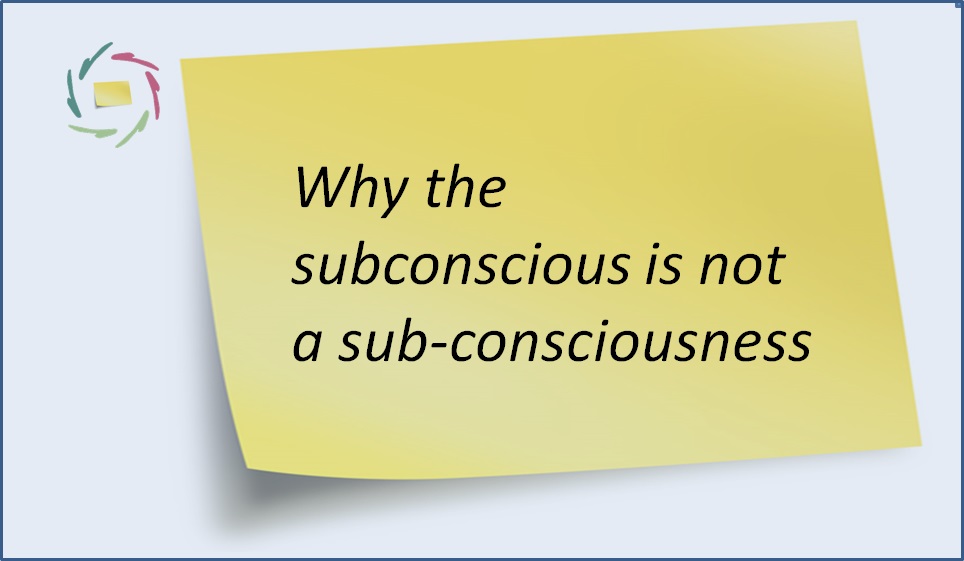About ‘Subconceptual’ (From My PhD Thesis)

The brain is continuously undergoing plastic remodeling through dynamically changing neural networks. This is about processing at the subconceptual level.
[Please read first: ‘About Concepts’]
Subconceptual processing (SP)
deals with the way that we perform any mental action as seen in fine detail. Small elements (neurons, dendrites, synapses…) in our brain act together to form patterns of activity that make up how we feel, think and are motivated. In contrast to a semantic network where different nodes represent concepts, the distinct elements within a subconceptual neural/neuronal network do not. Instead of equating to a mentally accessible concept, each node represents something smaller. A mentally accessible concept arises through the interplay of many of these subconceptual nodes within a distinct pattern. Each node in turn participates in multiple patterns, and therefore in multiple concepts.
SP theory holds that this level determines what we think
and is thus also necessary towards an in-depth understanding of human mind, stating that: “in the dichotomy of conceptual and subconceptual processes may lie the key to achieving the fundamental understanding of the architecture of cognition and intelligence… it is also important to address the problem of modeling both types of processes (conceptual and subconceptual) in an integrated architecture, in order to strive for a better understanding of the overall cognitive architecture.” (Ron Sun, 1994, p.10-11) In neuronal networks, this is the case not only at basic sensory levels but also at higher levels of cognition: “Nervous systems… are vast networks of networks, with various regions specializing for various tasks. This is evident in sensory systems, such as the visual system, the olfactory system, and so on, but it seems also true of functions more highly cognitive, such as speech production, speech comprehension, planning, and conforming to social conventions.” (Churchland & Sejnowski, 1992, p.317)
To understand SP, the level of the individual neuron is necessary but not enough
“Networks of neurons in the cerebral cortex generate complex outputs that are not simply predicted by their inputs. These emergent responses underlie the function of the cortex. Understanding how cortical networks carry out such transformations requires a description of the responses of individual neurons and of their networks at multiple levels of analysis.” (Schummers, Mariño & Sur, 2004, p.430) Mental representations are cast in the substrate of neural distributed patterns in at least 2 ways: “Sometimes ‘representation’ refers to cognitive events happening now, such as a visual perception; other times it refers to the capacity (not now exercised) to have appropriate cognitive events, such as my capacity to recognize an osprey. Patterns of activity in networks hook up with the first sense; configurations of connection weights (which yield the appropriate patterns of activity when given specific inputs) hook up with the second sense. Think of the first as displaying knowledge and the second as the enduring structure, or background conceptual framework, that makes the current display possible.” (Churchland, 2002, p.296)
Patterns and pattern recognition are central.
The brain even repeatedly performs a lot of pattern recognition on its own previously formed patterns, towards always more abstract levels: “pattern recognition plays a fundamental role at all levels of processing, from sensation through reasoning… from an intensity pattern to a set of objects in three-dimensional space, from a sound pattern to a sequence of words, from a sequence of words to a semantic description, from a set of patient symptoms to a set of disease states, from a set of givens in a physics problem to a set of unknowns. Each of these processes is viewed as completing an internal representation of a static state of an external world. By suitably abstracting the task of interpreting a static sensory input, we can arrive at a theory of interpretation of static input generally… that applies to many cognitive phenomena in the gulf between perception and logical reasoning.” (Bechtel & Abrahamsen, 2002, p.103)
Since the distinct elements within a subconceptual network contribute to the formation of conceptual mental entities but are not themselves conceptual, the processing that they carry out can rightly be called subconceptual processing (SP). However, the term SP has seldom been used in the literature. Terms such as subconceptual level, knowledge or representation are more common. The term subconceptual processing is preferred by me because in the human – or animal – brain, everything is dynamic. This is one of the main differences between animal brains and computers. Furthermore, it is likely that the dynamic nature of our brains is an essential characteristic that makes us what we are.
There are continuously changing patterns, with change happening at several levels simultaneously:
“Neurons are highly specialized structures, are resistant to change, but are engaged in distributed neural networks that do dynamically change over the lifespan. Changes in functional connectivity, for example by shifts in synaptic strength, can be followed by more stable structural changes. Therefore, the brain is continuously undergoing plastic remodeling… Dynamically changing neural networks might thus be considered evolution’s invention to enable the nervous system to escape the restrictions of its own genome (and its highly specialized cellular specification) and adapt fluidly and promptly to environmental pressures, physiological changes and experiences. Therefore, representations of function in the brain may be best conceptualized by the notion of distributed neural networks… [Inputs to nodes] shift depending on the integration of a node in a distributed neural network, and the layered and reticular structure of the cortex with rich reafferent loops provides the substrate for rapid modulation of the engaged network nodes.” (Alvaro Pascual-Leone, 2009, p.141)
In the face of pattern recognition at multiple levels on the fly, we may also better understand how distinct thoughts do not appear in our head instantaneously and unconnectedly ‘as by magic’,
but instead develop over a number of milliseconds – during which time they can be influenced by many other patterns at the subconceptual level. Put bluntly, conscious conceptual thinking may only offer hindsight of what has already occurred at the subconceptual level. Therefore also and as a natural side-effect, we actually never think the same thought twice.
Although neurotransmitters and biochemistry as a whole play a major role in brain function, SP is not specifically about this:
“Mental states are not represented by molecules alone, or even by a mix of molecules. As we’ve seen, they are instead accounted for by intricate patterns of information processing within and between synaptically connected neural circuits. Chemicals participate in synaptic transmission, and in the regulation or modulation of transmission, but it is the pattern of transmission in circuits, more than the particular chemicals involved, that determines the mental state.” (LeDoux, 2002, p.261) SP is the ‘higher level’ that lies between biochemistry and the aspects of the human mind that we can perceive both introspectively and behaviorally. Relevant questions within SP are ones such as “How do we actually perform acts such as seeing, thinking, paying attention, being empathic and even being conscious?” The answers are couched in terms of neuronal structure, and into large and small neuronal patterns within our mind/brain. This is not the ‘where’ question – which regions of the brain carry out specific processes and which regions cooperate – but instead asks ‘how’.
Taking this approach, SP may evolve from the ‘bottom up’ to address domains that have historically been disconnected from the neuronal domain.
Psychology, philosophy, education and leadership are just a few of the domains that may be brought in scope. In several of these areas, there is a growing awareness of this connection. Curiously however, although medicine is intimately entwined with the mind/brain, there has been little progress in elucidating the nature of this connection. One major reason for this may be the fact that modern medical thinking and practice is largely based on the Cartesian model of mind/brain dualism that arose a few centuries ago – without acknowledging the role of SP, the mind and body appear as two separate entities. Descartes made the assumptions 1) that the mind (soul) and body are completely distinct, and 2) that through introspection, one can know everything that is present in one’s mind with certainty – and these views still often prevail. However, this difference between the physical and the psychological exists only in the eye of the beholder.
Contrary to the Cartesian view, SP provides a unified picture of the mind and body,
where neuronal patterns – made up of simple non-conceptual neuronal and synaptic nodes that act together physically – give rise to psychological phenomena such as thoughts, feelings, and motivations. The difference between the physical and psychological level becomes arbitrary, and there is no such thing as the body influencing the mind and vice versa – both are the same thing, although described in different terms. SP thus provides a concrete and scientific approach to overcoming Cartesian dualism – it is a pragmatic missing link between the mind and brain. It is not, however, a cold reduction of mind to matter, but instead represents an overlap where deeper meaning is imprinted on a concrete substrate. Meaning is not relativized away, but instead is greatly enhanced in value. This view has the potential to give medical practitioners deeper insights into pathogenesis, and to deliver relevant cures for many conditions.
SP is also related to the domain of artificial neural networks (ANN)
a field of artificial intelligence (AI) that is inspired by human neuronal networks. Here, researchers have been able to develop computational models for neuronal theories, such as coarse coding, automatic generalization and pattern recognition, and embed them in a computerized environment. This has enabled us to explore and better understand theoretical neuronal constructs, both giving insights into the workings of the human mind/brain and furthering the field of AI. Terms related to SP preferentially used by AI researchers are parallel distributed processing (PDP) and connectionism. Historically seen, “at the same time that computational neuroscience was moving beyond its roots in the first wave of neural network models, a second wave of researchers from cognitive psychology and AI adopted neural networks as a medium for modeling human cognition. This intersection of two previously distinct trajectories in the early 1980s produced the distinctive approach to network modeling known as connectionism. The primary goal was to achieve a deeper, more complete account of cognition than had been obtained from the rules and symbolic representations of the information processing framework. Both neural plausibility and computational power were attractive to connectionists, but primarily as means to the end of modeling and understanding cognition.” (Bechtel & Abrahamsen, 2002, p.107)
Note that despite extensive thought and research, there is still no explanation as to why the neural basis of an experience is specific to that experience,
rather than to another one or to none at all. Further research is needed to bridge this gap, and will require the ability to record the activity of many neurons at the same time.
References
Bechtel, W., & Abrahamsen, A. (2002). Connectionism and the mind. Oxford: Blackwell.
Churchland, P.S. (2002). Brain-Wise – Studies in Neurophilosophy. Massachusetts: MIT Press.
Churchland, P.S., & Sejnowski, T.J. (1992). The computational brain. Massachusetts: MIT Press.
LeDoux, J. (2002). The Synaptic Self – How Our Brains Become Who We Are. London: Penguin Books.
Pascual-Leone A. (2009). Characterizing and Modulating Neuroplasticity of the Adult Human Brain. In M.S.Gazzinaga (Ed.), The Cognitive Neurosciences. Cambridge: The MIT Press.
Schummers J., Mariño J., Sur M. (2004) Local networks in visual cortex and their influence on neuronal responses and dynamics. J Physiol Paris, 98(4-6), 429-41.
Sun, R. (1994). An introduction: On Symbolic Processing in Neural Networks. In R. Sun, L.A. Bookman (Eds.), Computational Architectures Integrating Neural and Symbolic Processes. Boston: Kluwer Academic Publishers.


